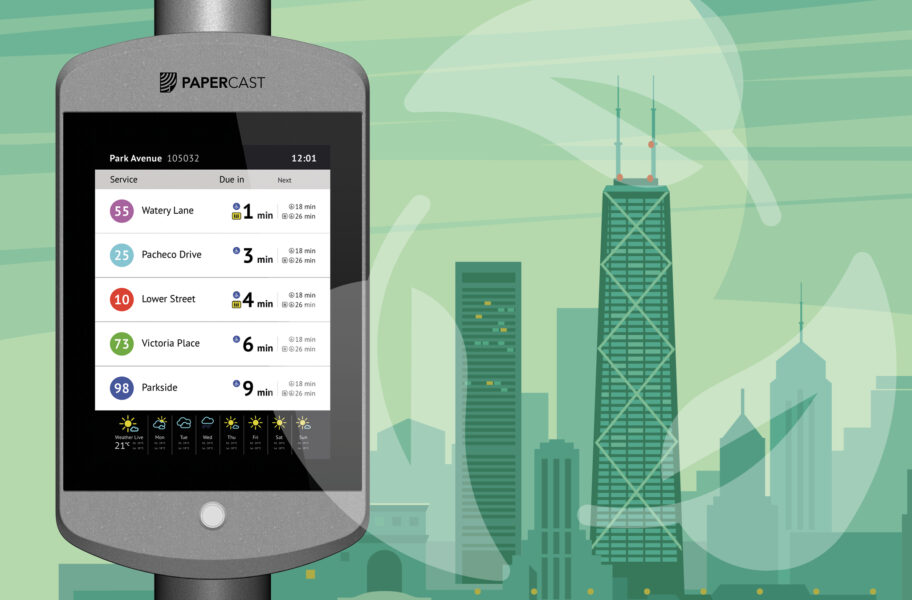
Meet the Papercast CMS Layout Catalogue: A must have resource for sharing visually impactful passenger information
We’re excited to tell you about the Papercast Content Management System (CMS) Layout Catalogue, an…

As cities worldwide strive for greener futures, sustainable technology is no longer a luxury – it’s a necessity.
At Papercast, we align with the industry’s sustainability agenda by addressing not only the role our products play in advancing sustainable urban mobility but also how they are thoughtfully designed and responsibly produced.
From eco-conscious design choices to responsible production practices, our e-paper technology reflects our commitment to minimising our environmental impact throughout the product lifecycle.
Drawing on insights from our Papercast Environmental Impact Guide, we delve into our approach to sustainability at every stage – and why it matters.
Also check out our recent article ‘10 ways in which real-time passenger information enables sustainable urban mobility’
A future defined by efficiency
Transportation accounts for nearly a quarter of global greenhouse gas emissions, making every watt saved a victory for the planet. Papercast e-paper displays consume just 2Wh of energy per day—ultra-low consumption made possible by our proprietary electronics and E Ink technology.
Why it matters: According to the International Energy Agency, improving energy efficiency could cut emissions by 40% by 2050, while targeted policies could slash transport CO2 by 30% or more. In a world where every decision contributes to a bigger picture, choosing energy-efficient technologies like Papercast offers a smart choice.
Power that redefines sustainability
We’ve moved beyond the grid to zero operational carbon footprint. Papercast offers two sustainable power options:
The impact: Hundreds of cities globally are integrating solar power into their smart transit systems, showcasing how sustainable energy solutions reduce costs and reliance on traditional power sources.
Circular economy in action
In a world plagued by e-waste, modular design is a game-changer. Papercast displays are built with repairability in mind: components can be swapped out, extending product lifespans and minimising waste.
Why it matters: The World Economic Forum emphasises the importance of circular economies to combat the global e-waste crisis: with 57 million tons of electronic waste generated annually—equivalent to the weight of all commercial aircraft ever built—yet only 20% is formally recycled. Papercast’s design philosophy puts sustainability into action; prioritising recyclable materials, reducing the need for replacements and keeping products in use longer.
Setting the benchmark in recyclability
Did you know that 99% of the materials in a Papercast e-paper display are recyclable? From laminated glass to aluminium housings, every component has been chosen to minimise waste. Even our packaging materials are fully recyclable. Contact our expert team for a detailed breakdown on Papercast display components and their recyclability.
Why it’s relevant: The Ellen MacArthur Foundation identifies material recyclability as a cornerstone of sustainable design. Built for sustainability from the ground up, Papercast’s products set a benchmark in recyclability.
Manufacturing that matters
Our manufacturing process is built on accountability. By adhering to stringent environmental standards, including Restriction of Hazardous Substances (RoHS) and Waste Electrical and Electronic Equipment (WEEE) directives, we ensure every stage—from sourcing to production—prioritises sustainability.
Industry insight: Sustainable supply chains aren’t just about compliance—they’re about building trust. Gartner reports that 87% of businesses plan to invest in supply chain sustainability by 2027. At Papercast, we are already there.
Measure it to manage it! Papercast tracks the environmental impact of production to reduce our carbon footprint and enhance sustainability, with our 28” e-paper display generating just 66.14 kg of CO2 during manufacturing.
For context: A 2.5 hour flight from London to Rome uses 234kg of CO2—3.5 times more than the total emissions from producing every component of a Papercast e-paper display, which delivers a 10-12 year lifespan of sustainable performance.
Inherent longevity, built for resilience
Our displays offer durability and longevity, leveraging E Ink technology capable of over 40 million content updates—equivalent to 12 years of use in average conditions.
Designed to endure extreme environments, our rugged displays are engineered to IP67 standards. Coupled with modular construction for easy repairs and tailored maintenance kits that enhance longevity, we strive to maximise the lifespan and ROI of our products.
Interesting fact: Extending the lifespan of electronic products significantly reduces their environmental impact. To prove this theory, Friends of the Earth reported that doubling the useful life of smartphones and laptops in Spain alone would prevent CO₂ emissions equivalent 17,000 cars in one year. Wow!
Responsible end-of-life management
When it’s time to retire a display, Papercast ensures the process is as sustainable as the product itself. Designed for easy disassembly, our displays align with WEEE standards, and we offer clear guidelines for the safe disposal of lithium batteries.
What’s at stake: Improper disposal of batteries can release harmful pollutants into the environment that harm ecosystems and pose fire risks. With local regulations tightening, our approach ensures compliance while protecting the environment.
Driving sustainability, shaping the industry
By choosing Papercast, you’re not just investing in a product—you’re joining a movement toward smarter, greener cities. Our commitment to energy efficiency, sustainable materials and ethical supply chains empowers transit authorities to reduce their carbon footprints while delivering exceptional functionality.
The bigger picture: Sustainable innovation isn’t optional. As urbanisation accelerates, technologies like e-paper displays will be pivotal in shaping cities that work for both people and the planet.
Contact us to access the complete ‘Papercast environmental impact guide’ and learn more about our sustainable e-paper solutions.

We’re excited to tell you about the Papercast Content Management System (CMS) Layout Catalogue, an…

The REACT Trigger System is now available on Papercast displays We’re excited to share that…